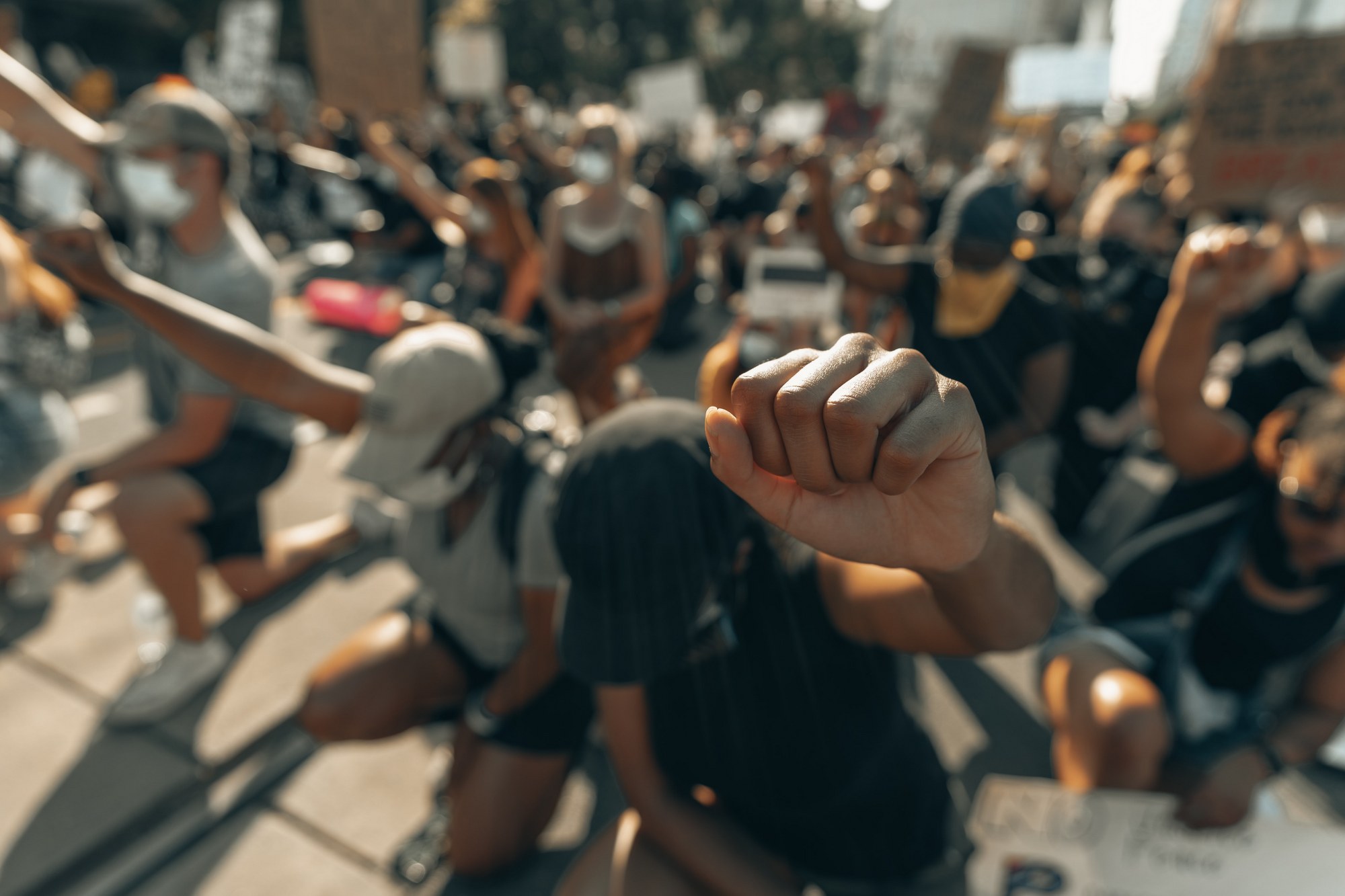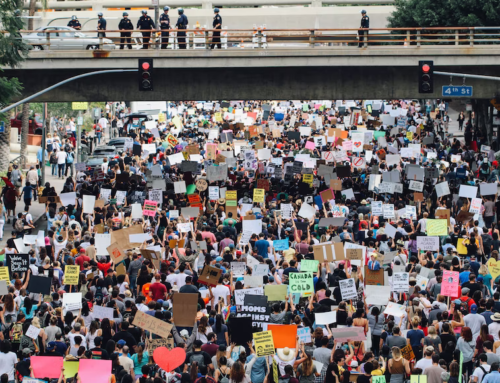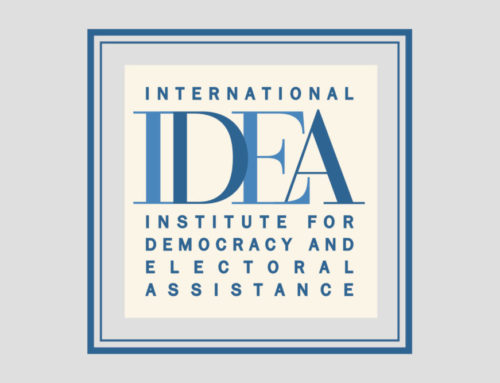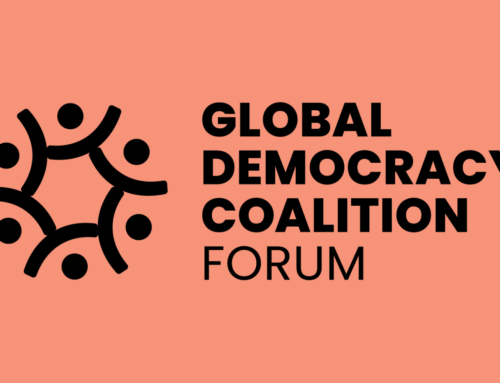Dedo N. Baranshamaje, Director of Strategy, Segal Family Foundation
Bryan M. Sims, Senior Manager, Peacebuilding, Humanity United
As the world’s democracies prepare to gather at the Summit for Democracy on December 9-10 and Open Government Partnership Global Summit December 15-17, we must urgently reconsider how we counter nearly two decades of democratic decline.
Given the rise of nonviolent social movements across the globe over the past decade, there is an opportunity to expand how we think about civil society and how to engage the grassroots. This swell of people claiming their power through nonviolent action represents a necessary condition for democracy–an engaged public free to express itself. While there is a coordinated effort among autocrats to restrict civic space, nonviolent social movements remain catalysts for significant change. Research has demonstrated that civil resistance remains a driver of democratic development with 57% of nonviolent movements yielded democratic outcomes five years after a movement ceased. By undertaking great physical and professional risk, hundreds of thousands of people – from violent and authoritarian regimes like Sudan, Venezuela, and Hong Kong, to more established, yet flawed, democracies like France, India and the United States – are using their voice and agency to demand inclusion, justice, dignity, and the application of their rights.
Nonviolent social movements redefine power by defying traditional approaches and leveraging alternative and innovative solutions to global challenges, including those threatening democracy. As a result, we need to be including nonviolent social movements in conversations centered around establishing and upholding democratic norms and values. As an added advantage, the establishment and upholding of democratic norms and values can also lead to more sustainable peace in highly polarized societies.
For those of us occupying the privileged donor space – this includes philanthropy, bilateral donors, and INGOs that provide subawards – we have an opportunity to draw attention to the importance of nonviolent social movements in supporting inclusive and sustainable democracies. Donors can play an important role in resourcing and sharing lessons around supporting social movements.
Over the past decade we have learned some lessons in how donors can support and show up for movements:
Lesson 1: Bring together diverse and proximate groups with flexible resources and support to blend civil resistance and peacebuilding approaches
Nonviolent social movements are broad-based and rooted within communities, they’re led by and for the very people grappling with injustice. Evidence has shown that building nonviolent civil resistance knowledge and skills lowers barriers and expands participation – a critical ingredient in societies permeated by apathy, distrust, and fear – that can strengthen individual and collective abilities to advance reforms from the bottom up. However, as we’ve seen, the transition from protest to power is fraught and fragile. Transitions in Ukraine, Myanmar, and most recently, Sudan have fallen victim to polarization, distrust among competing groups and the institutions needed to deliver sustainable peace.
Traditional methods and strategies of resource building around nonviolent social movements continue to be challenging and undemocratic, often devaluing the power of the movements themselves. As donors, we must recognize that we are often complicit in sowing divisions within movements by using our resources to ‘king-make’, endowing singular entities with finances to ‘take the movement forward’ to the exclusion of others. Nonviolent social movements, however, require flexible funding support to share experiences and knowledge on organizing and mobilization tactics and strategies.
For example, one innovative method to bring together different groups to learn and share is being pioneered by the African Coaches Network, an informal network of embedded coaches throughout Africa. These individuals have day jobs but are embedded within social movements within their own countries to strengthen the movements’ capacity to depersonalize and articulate shared grievances, bridge community divides, or support movement leaders within the context of negotiations with powerholders. They share lessons around strategy, and the repressive responses states are using to disperse mass collective action. This increases collaboration between activists and traditional NGOs, and allows movements to become more proactive and seek out opportunities to build solidarity across borders.
In an effort to increase participation, another community-based approach that’s worked in deeply polarized societies permeated by decades of trauma and violence is systems mapping. In Zimbabwe, three organizations from different sectors, but each proximate to their country’s conflict, embarked on a year-long effort to seek out marginalized voices and build a shared understanding of the root causes of their country’s protracted conflict. By blending peacebuilding approaches – particularly inclusive dialogue, facilitation, negotiation and mediation – different actors, movement leaders and allies are better equipped to move powerholders from their fixed adversarial positions and seek inclusive and shared goals.
Financial accountability and bureaucratic rules and regulations have forced many traditional donors to alter what they fund – moving away from resourcing convenings and information and knowledge sharing gatherings to uni-directional forms of engagement such as ‘capacity building and training’. Supporting movements requires a different approach. Beyond a willingness to provide resources for travel, convening space, digital infrastructure and security, we need to rethink how we measure people power. Mobilisation Lab is one of the thought-leaders behind ditching “vanity metrics” and seeking meaningful means to measure relationships, engagement and network strength, and the depth and progress toward achieving a mission.
Lesson 2: Support research on topics that can bolster campaigns and empower the “underdogs” in a negotiation
If violence is the only product on the shelf, then people will use it. It is important to develop and share tangible examples of movement effectiveness. Information and resources about nonviolent civil resistance strategies and tactics need to be available, understandable, and attractive to people. Both the International Center on Nonviolent Conflict, the United States Institute of Peace, and Beautiful Trouble have developed compendiums detailing successful civil resistance models and tools. As donors we should be promoting, translating, and supporting the use of these resources, and others as a way to support movements to make decisions about effective next steps and direction of action.
Movements are also frequently stymied by power imbalances between those that have power and information and those that do not. For example, one area rapidly galvanizing coalitions and movements across the globe is corruption. Accurate information on spoilers and kleptocratic networks are key for movements to increase their bargaining power within imbalanced negotiations. In our experience, movements have used this information to build intentional networks within and across borders to ensure a more equal playing field between power-holders and those seeking inclusive and sustainable pacts.
However as we’ve seen in Guatemala, Malta, Palestine, and countless other places, tracking, exposing, and organizing around corruption is dangerous. Donors can play an important role in enabling local communities by taking on risks and directly contracting the research to explore topics that are too dangerous for domestic partners to carry out. Donors are often also well placed, by virtue of their proximity to policy makers and legislators in the Global North to take on the risks of publishing and disseminating this information – putting it out into the public space where it is free to use. They can also ensure that recommendations that are often rooted in legal, regulatory, and financial complexity are channeled into action among partners. For those funders that are not able to provide direct resources to a movement, this is an opportunity to support the broader movement ecosystem and still be valuable to the movement itself.
Lesson 3: Build a movement mentality among membership-based NGOs
Supporting NGOs to be creative and work together in an era rife with deepening distrust, polarization, and disinformation is critically important for movement building. In order to achieve this, we as donors need to not perpetuate competition amongst NGOs nor between NGOs and activists. For more than a decade, donors have recognized the need to be flexible, but too many of us continue to have rigid administrative and funding structures that make groups and organizations compete for funding in ways that defy authentic movement and coalition building. Donors should also break out of their own silos, joining together to fund across the boundaries of democracy, nonviolent social movements, and peacebuilding, even when these ecosystems can feel quite different.
Our systems and processes need to embrace failure and learning, incentivize relationship building, and reinforce a commitment to nonviolence – which is proven to ensure greater participation – in order to propel demands for change into the mainstream discourse. Donors need to support organizational mechanisms of governance that engender agility and disseminate decision-making downward if NGOs are to have a greater chance of successfully building a critical mass of supporters.
The goal is to incentivize collaboration and reduce competition so that movements and their allies can be greater than the sum of their parts.
Conclusion
We don’t know what the ‘post-pandemic’ world will look like. We do know that technology is altering how we communicate, organize, mobilize, and build solidarity. We also know that vulnerable populations, in both fragile and stable countries, feel excluded from unaccountable institutions and are being polarized and radicalized by disinformation and dark money.
As civic, political, and private leaders gather at the Summit for Democracy and the Open Government Partnership Summit, they need to recognize that sustainable solutions to these rapidly evolving challenges mean bringing meaningful commitments to the kinds of ideas mentioned above, supporting bottom-up democratic processes and building on the wave of energy that is growing through these movements. If their commitments remain high-level, implementation will be difficult and will not recognize nor align with the power and energy of communities and democracy defenders on the frontline.
History has provided clear lessons for when we fail to get this right. By supporting nonviolent social movements, we can help defend democracy from the existential threat of rising authoritarianism.





Leave A Comment